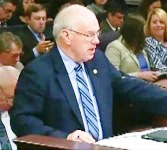|
Article
Courtesy of The Orlando Sentinel
By Senator
Alan Hays
Guest Columnist
Published
June 26, 2015
In November
2014, 4.2 million Floridians, roughly 20 percent, or one in five of the
nearly 20 million people who call our state home, voted in favor of the
Water and Land Conservation Amendment (Amendment 1).
As stated in the ballot summary, the amendment dedicates 33 percent of
documentary-stamp tax revenue to "acquire, restore, improve and manage
conservation lands including wetlands and forests; fish and wildlife
habitat; lands protecting water resources and drinking water sources,
including the Everglades, and the water quality of rivers, lakes, and
streams; beaches and shores; outdoor recreational lands; working farms and
ranches; and historic or geologic sites," for 20 years.
|
The Legislature has worked diligently to
implement this amendment, which will set aside $741.8
million from existing revenue this year. It is projected to
generate $22.3 billion over the next 20 years.
The good news is the Legislature did not wait for the
passage of Amendment 1 to renew its dedication to funding
Florida's environment; nor did we limit funding for this
purpose to the mandatory $741.8 million. |
|
|
Recovering from a recession that impacted every area
of the budget, the Legislature last year appropriated well more than $3
billion in funding for environmental programs, dedicating approximately
21 percent of documentary-stamp revenue as well as general revenue,
federal grants and other state funds to conserve, protect and enhance
the natural resources we Floridians treasure.
This tremendous level of funding demonstrates the long-term and
broad-based commitment to conservation by our local, state and federal
governments that has led to the purchase of more than 10 million total
government-owned acres across Florida, a commitment clearly reflected in
the balanced budget the Legislature passed on Friday.
The 2015-16 budget provides substantial funding for land acquisition,
springs protection, recreational trails and restoration of the
Everglades. The budget provides nearly $200 million to pay for existing
debt the state owes within Florida Forever, the Everglades and the
Florida Keys. In addition to dedicating more than $50 million toward the
purchase of even more conservation land, the budget dedicates hundreds
of millions to improve the management of and expand public access to
lands the taxpayers already own.
We also dedicated tens of millions to nourish
Florida's beaches, restore our lakes and protect rural and family lands
from development. We set aside funds to protect endangered plants and to
mitigate the harm caused by invasive species that threaten various
habitats across Florida. We also allocated significant funding to
improve the quality of our water resources.
As you can see, there is a whole lot more to being a conservationist
than acquiring property.
And while the proponents of Amendment 1 would now like us to believe
their purpose was to require the state to purchase more land, the ballot
language above clearly shows there is no requirement to spend a specific
portion solely on land acquisition. Neither does the language indicate
the entire sum is to be used for new purchases.
Rather, the actual text of the amendment recognizes the broader
responsibility in protecting and improving the state's natural
resources. In fact, arguing in favor of Amendment 1 before its passage,
proponents contended the amendment would not require cuts to other
programs or increases in revenues since nothing in the amendment
prevented the use of funds for existing programs, including operating
expenses.
Some have compared Amendment 1 funding for the environment to the
Florida Lottery funding dedicated to education. Let's be clear: The
lottery generated new funding for the state. Amendment 1 does not
generate any new funding. Rather, it mandates the allocation of an
existing revenue stream now be set aside to fund environmental purposes.
Currently, about 21 percent of doc-stamp revenue supports environmental
programs, and these expenditures were continued. Amendment 1 required an
increase to 33 percent, so the general revenue fund that supports our
school system, health care and other state needs was reduced by $174
million to implement the amendment.
Addressing Florida's environmental needs is a marathon, not a sprint.
Our budget not only meets, but by every measure exceeds the requirements
of Amendment 1, which, unlike the current rhetoric, recognizes that
being good stewards of Florida's natural beauty means more than simply
buying land.
Sen. Alan Hays represents District 11, which
consists of parts of Lake, Marion, Orange and Sumter counties. He has
served the last three terms as chair of the Senate Appropriations
Subcommittee on General Government, which includes agriculture and
natural resources.
|
